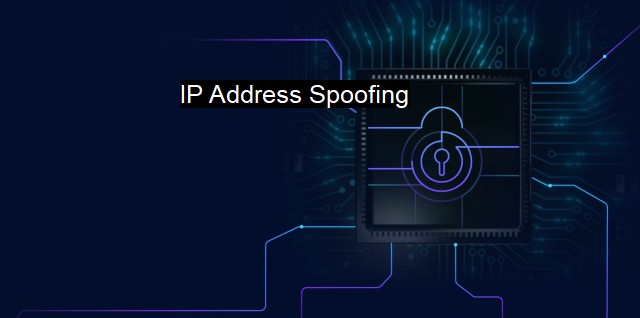What is IP Address Spoofing?
Unmasking the Danger: The Perils of IP Address Spoofing in Cybersecurity
In the field of cybersecurity and antivirus technology, a particularly malicious technique known as "IP Address Spoofing" is commonly used by cyber-attackers to infiltrate and destabilize networks. Understanding this tactic, its impacts, and ways to prevent it is a fundamental aspect of network security."IP Address Spoofing" refers to the method by which hackers manipulate the IP address of packets transmitted over the internet, aiming to trick the recipient's network or system into believing that the packet is from a trusted source. IP, or Internet Protocol, is a set of rules governing internet communications, tracking and arranging data packets which are transferred across networks. Each device connected to a network acquires an IP address, a unique identifier, facilitating the tracking of transmitted data, almost working as a return address in physical mail.
IP Address Spoofing thrives on the basis that trusted IP addresses are less likely to be blocked by firewalls or other security measures, hence obstructing the detection of harmful cyber activities. Cyberspace is like a vast open sea where packets of information travel continuously. Picture a boat containing goods — the IP address would be its flag showing its origin. In spoofing, attackers change this flag to disguise the boat's real origin, fooling the receiving port into accepting dangerous cargo.
Attackers use IP Spoofing for a variety of malicious activities, such as launching Denial of Service (DoS) or Distributed Denial of Service (DDoS) attacks. Their objective is to overwhelm a targeted server, service, or network with overwhelming internet traffic coming from multiple spoofed IP addresses, flouting the regular functioning and potentially leaving the system susceptible for additional attacks.
IP Spoofing is also used in IP blind attacks when an attacker denies feedback from a network happening at the transport level of the IP stack to establish connection using a spoofed IP address. Also, in session hijacking, the attacker applies IP spoofing to barge a session between client and host, inspect data, and insert malicious files.
Despite IP spoofing perils, there are several countermeasures available to protect against this form of cyber attack. Network ingress filtering, a technique that staunchly restricts packets with spoofed addresses from entering the network, is an efficient protection mechanism. By configuring routers and firewalls to deny packets from outside the local network that use internally valid addresses, ingress filtering minimizes the risk of IP Spoofing attacks.
Techniques such as anomaly-based intrusion detection systems (IDS) assist in identifying possible spoofed IP packets. By recognizing the traffic patterns and analyzing them with expected behavior, this system flags potential threats. It thereby notifies administrators to further investigate or take immediate actions if required.
Implementing sufficient security policies, like restrictive routing, advanced IP concepts like cryptographically generated addresses (CGA), aids in lowering threats emanating from IP Spoofing. Regularly updating and patching systems, along with a vigilant monitoring for unusual traffic patterns, also safeguard against such attacks.
IP Address Spoofing presents a significant threat in the cybersecurity landscape. understanding this technique and implementing strong security measures, alongside reliable antivirus technology, can provide robust defense mechanisms to protect networks and systems from such malicious attacks.
As with any cybersecurity threat, maintaining frequent, systemic assessments for dormant or active threats is essential. The unpredictability and ever-evolving nature of threats necessitates an active and constantly improving system of defense, of which understanding IP Address Spoofing is a crucial part.

IP Address Spoofing FAQs
What is IP address spoofing?
IP address spoofing is a form of cyber attack where an attacker disguises their IP address to make it seem like they are someone else. This can be done to evade detection or to launch an attack on a computer network.What are the risks of IP address spoofing?
The risks of IP address spoofing include unauthorized access to sensitive information, data theft, malware injection and spamming. It can also be used to launch DDoS attacks, which can overwhelm a network and take it offline.How can I protect myself from IP address spoofing?
To protect yourself from IP address spoofing, you can use a firewall to block traffic from unknown sources, use strong passwords to secure your accounts, and keep your software up to date. You can also use anti-spoofing technology, such as packet filtering or IP sec, to prevent spoofed packets from reaching your network.What should I do if I suspect IP address spoofing?
If you suspect IP address spoofing, you should contact your IT department or network administrator immediately. They can trace the source of the attack and take steps to block the attacker. You may also want to use antivirus software to scan your system for any malware or viruses that may have been introduced by the attacker.| | A | | | B | | | C | | | D | | | E | | | F | | | G | | | H | | | I | | | J | | | K | | | L | | | M | |
| | N | | | O | | | P | | | Q | | | R | | | S | | | T | | | U | | | V | | | W | | | X | | | Y | | | Z | |
| | 1 | | | 2 | | | 3 | | | 4 | | | 7 | | | 8 | | |||||||